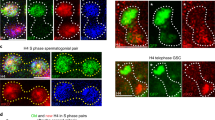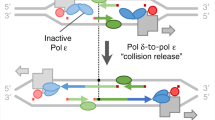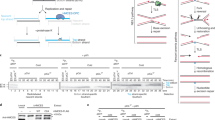Abstract
5-BROMODEOXYURIDINE (BUdR) inhibits cell differentiation and embryogenesis and yet has little effect on cell division or metabolism1. When sea urchin embryos are grown in the presence of BUdR, pre-gastrula DNA accumulates as 30–60S duplex pieces2. We have now found that naturally occurring, regularly spaced, single-stranded regions in morula DNA3 are the sites at which BUdR-induced breakage occurs, resulting in production of these 30–60S low molecular weight DNA pieces. The DNA pieces from morulae grown in BUdR are approximately half the length of DNA molecules from control embryos grown in thymidine (TdR).
This is a preview of subscription content, access via your institution
Access options
Subscribe to this journal
Receive 51 print issues and online access
$199.00 per year
only $3.90 per issue
Buy this article
- Purchase on Springer Link
- Instant access to full article PDF
Prices may be subject to local taxes which are calculated during checkout
Similar content being viewed by others
References
Rutter, W. J., Pictet, R. L., and Morris, P. W., A. Rev. Biochem., 42, 601–646 (1973).
Baker, R. F., and Case, S. T., Nature, 249, 250–352 (1974).
Case, S. T., Mongeon, R. L., and Baker, R. F., Biochim. biophys. Acta, 349, 1–12 (1974).
Piko, L., Tyler, A., and Vinograd, J. Biol. Bull., 132, 68–90 (1967).
Piko, L., Am. Zool., 9, 1118 (1969).
Ando, T., Biochim. biophys. Acta, 114, 158–168 (1966).
Kavenoff, R., and Zimm, B. H., Chromosoma, 41, 1–27 (1973).
Appleby, D. W., Hearst, J. E., and Rall, S. C., Fedn Proc., 33, 1282 (1974).
Habener, J. F., Bynum, B. S., and Shack, J., Biochim. biophys. Acta, 195, 484–493 (1969).
Person, S., and Sclair, M. H., Radiat Res., 33, 66–73 (1968).
Thomas, C. A., jun.,and Abelson, J., in Procedures in nucleic acid research, (edit. by Cantoni, G. L., and Davies, D. R.), 553–561 (Harper and Row, New York, 1966).
Studier, F. W., J. molec. Biol., 11, 373–390 (1965).
Davidson, N., and Szybalski, W., in The bacteriophage lambda (edit. by Hershey, A. D.), 48 (Cold Spring Harbor, New York, 1971).
Kotzin, B., and Baker, R. F., J. Cell Biol., 55, 74–81 (1972).
Tyler, A., Biol. Bull., 104, 224–229 (1953).
Sutton, W. D., Biochim. biophys. Acta, 240, 522–531 (1971).
Author information
Authors and Affiliations
Rights and permissions
About this article
Cite this article
CASE, S., BAKER, R. Position of regularly spaced single-stranded regions relative to 5-bromodeoxyuridine-sensitive sites in sea urchin morula DNA. Nature 253, 64–66 (1975). https://doi.org/10.1038/253064a0
Received:
Revised:
Issue Date:
DOI: https://doi.org/10.1038/253064a0
This article is cited by
Comments
By submitting a comment you agree to abide by our Terms and Community Guidelines. If you find something abusive or that does not comply with our terms or guidelines please flag it as inappropriate.



